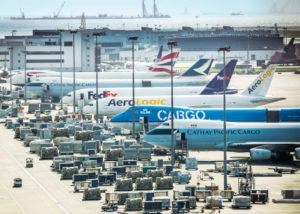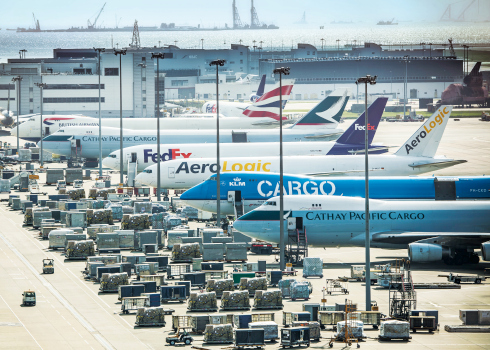 Both air cargo traffic and passenger demand continued their robust year-on-year growth through 2017 across the world’s major airports despite the looming specter of trade wars and protectionism, according to Airports Council International (ACI) in its latest world airport traffic rankings report.
Both air cargo traffic and passenger demand continued their robust year-on-year growth through 2017 across the world’s major airports despite the looming specter of trade wars and protectionism, according to Airports Council International (ACI) in its latest world airport traffic rankings report.
Air cargo volumes at the world’s 20 busiest airports grew by 6.8% in 2017, as these hubs handled a combined 51 million metric tonnes of cargo, representing 43% of global air cargo volumes.
Hong Kong (HKG) occupied top spot as the largest air cargo center, handling more than five million metric tonnes of cargo in 2017. Volumes at HKG grew by 9.4% year-on-year. Shanghai, Chicago, and Doha all experienced double-digit growth of 11.2%, 12.6% and 15.0%, respectively.
Air cargo experienced a revival across many of the world’s airports in 2017 and into 2018, said the ACI report.
“Even with the uncertainty regarding the threat of trade wars and the growth of protectionist sentiments across the world, business confidence has remained strong through inventory build-ups and increased export orders in 2017,” it said.
“The surge in cargo volumes and passenger numbers across many of the world’s airports is testament to heightened business and consumer confidence, at least in the short term,” said Angela Gittens, director general, ACI World.
Gittens also noted the role of e-commerce in the pickup of air cargo traffic.
“The universal access to online retail and e-commerce platforms represents a competitive pressure to the traditional brick and mortar retail shops in certain markets but the huge growth in e-commerce has fuelled the air cargo side of the airport business. This has resulted in increased global activity, especially in major markets such as China and the US.”
Gittens added, “The spectre of uncertainty regarding trade policy among major economies comes at a time when global commerce and our industry has recently thrived. The trans-pacific link, for instance, is an important ingredient in boosting international passenger traffic and international freight volumes”
“Connecting people, business and places still remains paramount to the aviation sector despite the recent threats of a step backwards in market liberalization in some major economies,” Gittens continued.
Based on total cargo, the top 20 air cargo airports in 2017 are Hong Kong, Memphis, Shanghai, Incheon, Anchorage, Dubai, Louiseville, Tokyo, Taipei, Paris, Frankfurt, Singapore, Los Angeles, Miami, Beijing, Doha, London, Guangzhou, Amsterdam, and Chicago.
Passenger numbers up 5.2%
On the other hand, passenger traffic at the world’s 20 busiest airports grew by 5.2% in 2017. With almost 1.5 billion passengers passing through their terminals in 2017, this group of 20 represents 17% of global passenger traffic, said the report.
Indian and Chinese airports were major contributors to the growth. Delhi jumped from 22nd to 16th, solidifying its status as one of the fastest growing airports in the world for passenger traffic; Guangzhou in China grew by 10.3% making it the second fastest growing airport among the top 20.
The top 20 busiest airports in terms of total passenger traffic are Atlanta, Beijing, Dubai, Tokyo, Los Angeles, Chicago, London, Hong Kong, Shanghai, Paris, Amsterdam, Dallas/Fort Worth, Guangzhou, Frankfurt, Istanbul, New Delhi, Jakarta, Singapore, Incheon, and Denver.
Photo courtesy of HKIA





